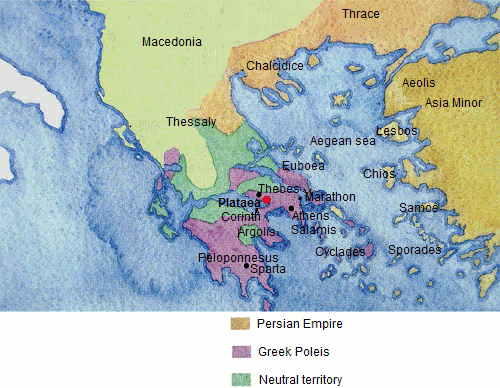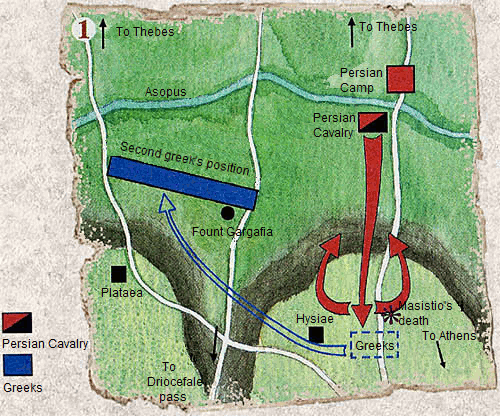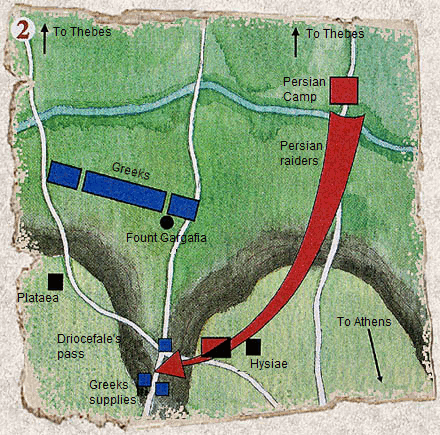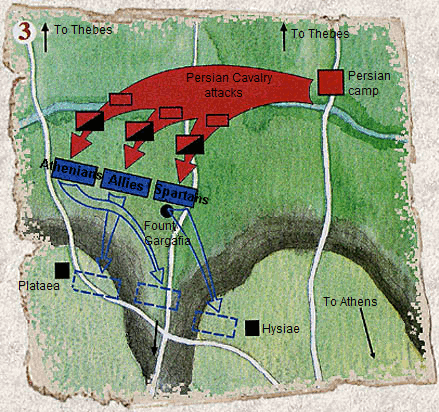

27 August 479 BC
The ultimate defeat of king Xerxes and the end of the Persian wars.
PLATAEA
Nephew of Leonidas, Thermopylae Hero (fell against the Persians), Pausanias was the temporary King of Sparta as guardian of Pleistarchus (son of Leonidas), King by right, but still a minor. This situation granted him the command of all the Allied forces, but was not sure that this was role that perhaps he expected. The real winners were the spartans infantrymen, the Hoplites. In fact does not risult that the Greek leader has given a clue in war with indisputable actions dictated by tactical intuition. Surely we know that Pausanias, after the victory at Plataea, led the Greek fleet to the conquest of the Bosphorus and, since then, its political interests took a turn to the East in stark contrast with the sober-minded Warrior, typical of Spartans. This attitude caused him the forced come back to his homeland, but once returned later in the Dardanelles to settle here, he wove strange and complicated political relations with the Persians, which secured the Athenian antipathy. The same athenians managed, shortly after 471 BC, to get permission from Sparta to drive him out from the Dardanelles. So Pausanias decided to return to his homeland once again, in this case to seize power, supported by the Helots (the Helots were Spartans slaves belonging to the State) and by Themistocles (also banished from Athens), in an attempt to overthrow the oligarchic Government that was erected at the city's command. But was once again politically defeated and sentenced for treason (due to his contacts with the Persians). He tried to save his own life and take refuge in the Temple of Athena, where he couldn't be touched because of tradition, so was walled up alive.
The figure of this Persian conqueror dates back only to the Persian wars. Son-in-law or nephew of Darius I, in 492 BC was appointed by the King to wage war to Greece and put under Persian control throughout the northern Aegean and Thrace. Mardonius in fact, well started his adventure as Commander conquering the island of Thasos, but had no great fortune later. He lost 300 ships due to a storm that took his fleet near Mount Athos, forcing him to return back.
As described by the poet Herodotus, the Persians had as fundamental characteristic: great skill on horseback and archery; they were bearers of great ability; but above all, great courage in the battle. Mardonius too was certainly provided of great courage (as many of the Persian leaders, he preferred to die in battle rather than recoil), but it was lacking in sincerity. Indeed, Herodotus recounts that, to his own King Xerxes, Mardonius reported that the Greeks had far less fearsome than expected, perhaps because, according to him, they chose the battlefield more for beauty than for its practicality. These were opinions that ranged in contrast with what was told in Persia of the Greeks, but, above all, was a great falsehood that the Commander discovers and will pay a dear price showing his true character: beside his courage he lurked an enormous presumption.
PLATAEA
The Medes and Persian populations of Indo-European origin settled in the Iranian plateau in the third millennium, occupying the richest part of the region with water currents, mines of copper, lead and iron. The Persians were a civilized people, had already tamed the horse and knew how to work the iron, two unknown activities to many of their "neighbors" like the Semites. Then, in the 6th century, as logical, the Persians began the construction of their empire. The first great Persian leader was Cyrus the great, who conquered the Kingdom of the Medes, Lydia of Croesus, the territories in the East to the Indus River and in 538 b.c. Babylon. His successors prosecuted his project: Cambyses seized Egypt (battle of Pelusium in 525 BC) and Darius I started an admirable administrative organization that consolidated the Empire.
The Persians were remembered for great public works as the many bridges in masonry, for efficient postal service, for the road that linked the capitals of the Kingdom and the capitals of the administrative districts (Provinces), and for maritime connections between the different provinces of the Empire through the opening of a canal from the Nile to the Red Sea, works accomplished thanks to a tax levy ordered and rigorous. But most of all must be give merits to the Persians for the modernity of attaching the basics principles of social management: respect for local cultures and religions, decentralization and decision-making autonomy granted to the provinces, acceptance of the particularities of each economic people from their submissive.
But this forward-thinking directors would bring serious problems; in fact over the years, the Governors of the provinces (satraps) managed to amass great wealth to create private militias difficult to control as their sources of income. This facts went hand in hand with a military weakness due to the fact that people believed that the mission to defend them from enemies beloged to their King and not that they had to protect him. These internal cracks will be completely showned during the advance of Alexander the great which subsequently swept literally the Persians.
PLATAEA
A very important role in Greek culture was held by Ionia, with his dodecàpoli (twelve) and Miletus on all. Forced to move mainly by sea, the settlers of Miletus thoroughly studied the sciences as astronomy, and cartography, indispensable for those who must necessarily move to sea. But alongside this great scientific culture, in Miletus flourished one of the earliest philosophical cultures of the Western world whose most famous representatives were: Thales, Anaximenes and the more important, Anaximander (615-540 BC).
Anaximander had been disciple of Thales and already, at that time, stated that the moon shone for the reflected light of the Sun; was the first to publish a geographical map and thanks to him that was introduced in Greece the use of gnomon, already known by the Egyptians, the first tool for modern astronomy. Thanks to this instrument, they could establish hours and seasons, but what is even more important to navigators as the Milesian, they could calculate the latitude coordinates of a specific place.
The Milesian also foundated several empòria, malls that controlled trades of the surrounding areas. Among these one of the most famous in antiquity was the harbour of Sinope, nearby the river Halis, which was the seat of prestigious and thriving shipyards because of the abundance of wood and iron mines in the hinterland.
PLATAEA
The protagonists of one of the first clashes between the Greeks and Persians were the cities of Ionia, Miletus in particular. Citizenship demonstrated reluctance and dissatisfaction since Darius imposed (usual costume of Imperial Administration) Governors, tributes and foreign garrisons. The two old tyrants of Miletus, Aristagoras and Istieo, exploited this wave of dissatisfaction and received help from the city of Athens (20 ships), showing it to be able to get a gain in side the Ionic cause. But already in 494 BC the revolt had been suppressed, Miletus destroyed and its inhabitants sold as slaves to Babylon. This episode alarmed, however, the Persian King, who sent an expedition to punish those who had helped the rebels. Unfortunately for Darius in 492 BC, the Persian army suffered a tough defeat at Marathon and his fleet was wrecked at Mount Athos, ending, tragically, the expedition.

Xerxes, son of Darius, prepared a new expedition with much more care and abundance of facilities and men than did his father. In 480 BC the new King outdid the Hellespont by a bridge of ships, continued at the head of his huge army across Thrace, Macedonia and Thessaly, always stocked with everything from its fleet, supporting him from the sea. Meanwhile, the Greeks, at the Congress of Corinth, couldn't find a common agreement against the advancing Persians: Athens and Sparta decided to oppose the Persians while all other cities weren't persuaded to join a enterprise that was very tough.
Obviously, the command of the Allied forces was given to Sparta. Euribiade was officially the Commander of the fleet (composed of about 300 trirems), but the naval strategist was the Athenian Themistocles. At the Spartan king Leonidas were entrusted the 7000 Hoplites which he headed at Thermopylae, a step between Thessaly and Central Greece. There he was bypassed and after three days of resistance he sent back much of the army. Despite the number of opponents was vastly superior, he stayed with about 1000 men among Spartans and Tespians (inhabitants of Thessaly): all in vain but heroic attempt, to defend, to the last, all passes and slow the Persian advance. All the Greek army retreated then on the isthmus of Corinth, to defend the entire region of the Peloponnese, abandoning even Athens to its fate.
The sacrifice of Thermopylae wasn't totally unnecessary, the fleet had the time to withdraw free from Artemisium and wait the Persian ships in a strait between the island of Salamis and the Mainland. Fast Triremes Greeks forced the Persian ships to approach the coast. At this point the agility of the Greek ships prevailed on many and heavy Persian ships were unable to maneuver more practically, resulting as easy targets for those who could moved into familiar waters. Once again, agility, great determination and sagacity had prevailed over numerical superiority.
No longer protected and flanked by his fleet Xerxes did pick up survivors and ships leaving Mardonius in Thessaly, for the winter, in order to prepare the assault for the next year. Meanwhile, Mardonius failed to reignite the internal strife between the pòlis, indeed, was forced to withdraw into the ally Boeotia looking for forage and for adequate protection of natural elements.
PLATAEA
PLATAEA
The core of the Persian army was composed, obviously, by Knights and infantry officers of Iranian nationality. To complete this core, were asked to various Imperial provinces auxiliary armed, ships and sailors (in case of war by the sea) or horses and logistical benefits depending on the needings. These troops, which we can define support, came from all over the Persian world; Herodotus mentions up to 47 different nationalities, each with officers, military customs and different languages, but with a common element, the low military equipment.
Elite troops of the Iranians had great outfit for both the defense and the attack, and having been among the populations descended from early horse tamers, were absolute masters in charges, prepared by distance with shots unleashed by archers. The Iranian infantry was not to be outdone, composed as it was from the famous 10,000 "Immortals" who descended from the 10 originating Iranian tribes. The Persian war tactic was therefore based on mobility and power of cavalry charge, and the precision of the archers.
The Greeks, unlike the Persians, did not have a fixed fulcrum on which count in case of war. In fact each pòlis militia was formed by citizens (farmers or traders) who take the field to defend their city, but not always for long periods because of their occupations. The war for the Greeks had to be very short, and in battle thye were all tied to a bond of brotherhood gained among people in the communities native to where they lived. In internal clashes between the cities was consolidating, according to the ideal of compactness, a formation known as Phalanx ("roll"). Consisted of infantrymen heavily armed, called Hoplites, who had this equipment (panoply): helmet, breastplate, Greaves of bronze anatomical, round wooden shield covered by leather and iron-reinforced at the edges, sword and a long and solid spear. The Cavalry was virtually non-existent on the Greek front because hardly manoeuvrable on mountain landscapes of Greece. The auxiliaries were numerous but played a minor role in the battle, which belonged to those who had the financial facilities to provide the panoply.
The armies that faced each other chose a place, generally flat, and before battle made sacrifices in honor of the gods. At this point they deployed in 8 lines, shield on shield, with Spears pointed towards the enemy and occupying a total area of about 150 metres. Then he launched into a frightening charge straight against the opponent. Once placed the first impact to opposing line, the lines behind teammates had to press forward, with Spears pointed on the shields, in an attempt to injure enemies and crush the front rows and the enemy Phalanx. When they produced a gap in the opposing phalanx, they broadened it with the shields until it crumbled, so that less experienced men of the formation (the younger ones generally seats in the back rows) were caught in panic and fled.
PLATAEA
It is believed that the chosen soldiers King's guard, depicted in their precious garments in almost all capitals of the Kingdom, were called "Immortals" because of the care, taken by the Kings, in keeping them in number, but behind this assumption there are others, very different.
1. The first hypothesis, certainly the most fascinating, would represent these skilled archers armed with bows, or from wood provided by the biblical apple tree of evil and of good, the tree of immortality, present in the mythical Garden of immortality.
2. The second option instead (more realistic) has been interpreted as a simple form of propaganda of the power of the King.
PLATAEA
Mardonius, respecting the order of Xerxes, was due to stay in Thessaly to winter, and thanks to the figures provided by Herodotus, had approximately 300,000 men, from retouching maybe up to 100,000. Among these, only a small part was supposed to be Iranian, the major part was composed by contingents of mercenaries Scythians, Saka, while certainly unreliable troops were provided by Greek subject regions: Tessalians, Boeotians and Macedonians.
The two Greek commanders ( Pausanias the Spartan and the Athenian Aristide) could count on an army of about 80,000 men, (Herodotus indicates 108,700) divided in this manner: 13,000 were Spartan Hoplites and perieci (inhabitants of Sparta), divided into 5,000 Spartans, 600 Plataeans, 5,000 Corinthians, 600 Mycenaean and 1,800 from other small towns followed by almost 35,000 Helots. Among the remaining Hoplites (23,000) there were 8,000 Athenians, despite the city's forces were largely committed by the sea, and another 15,000 came from other allied cities.
Finally, from a geographical point of view, Mardonius had camped at the river Asopus, and had plenty of water, while the Greeks in the first days of August, stood at Eritre on the Cithaeron mount.
PLATAEA
In the days before the battle the cavalry Commander Masistio attempted a surprise attack to avoid that with each passing day the Greek force of impact increased. But his hopes of success broke against the compactness of the Greek phalanx, and above all against the hilly terrain that certainly not favored the movements of his knights. This first setback gave a lot more boldness to the Greeks and made more cautious the same Mardonius.

After the failed attack of the Cavalry the Greeks moved from their location, easy to defend but without water, to settle on the plain in front of the city of Plataea. For eight days (thus referring to Herodotus) the two sides faced each other without sticking, from the two banks of the river Asopus, the Greeks on the South Shore, the Persians on the north shore. The eighth day Mardonius ordered a raid of his knights in the Driocefale pass from where came the supplies for the Greeks; This action is repeated in the next few days: several convoys were destroyed without the Greeks could act in time to intercept the Persian Knights, too fast for them that were unprovided of cavalry and archers.


After the raids against the Greek supplies, the Persian Cavalry finally took the attack en masse and found the Allied troops stationed in this manner: on the left the Athenian Hoplites, Spartan ones on the right, while at the Center were willing the Hoplites of the other allies; thanks to this deployment, Athenians and allies had access to water of the river Asopus as the Spartans used the Gargafia source located behind them. The Persian cavalry charge was preceded by the launch of several javelins, which caused the setback of Athenians and minor allies. This fact forced even the Spartans, who had instead retained the position to setback along with the other. The Greek commanders, therefore, decided to abandon the positions of the plain (and thus water sources) to reoccupy the hilly areas behind them (thus the protection against cavalry), and especially the pass from which came the supplies that had been destroyed in the previous days. This operation was done with chronometric precision and at night; minor allies had to take a position at Plataea itself (on the left side of the Greek front), the Athenians would be established in the centre and the Spartans on the right. But something went awry, a Spartan contingent refused to leave the position, in a first time, and this caused a delay of the operation of the same contingent that at sunrise had not achieved preset positions.
At dawn Mardonius advanced the whole army, who had the Boeotians and Greek allies at right, on the left the Persians and the Asians. In the meantime, the cavalry was launched against the unit remained isolated on the Plains to block it while waiting the Imperial infantry. The Persians (Saka distinguished themselves for their value in this action) tried to avoid the clash in melee with Hoplites, continuing to throw javelins from distance. Soon came the infantry, that with one deployment to hedge, had the task of protecting with their slender shields the multitude of archers behind them, which began to target the Greek infantry.

Up to here the events seem to favour Mardonius, who made a serious mistake: he strucked too much the ranks between the units, assuming a more compact appearance, that could not contain the power of the "heavy" Greek phalanx. The Hoplites easily breached in the Persian troops and rejected the archers foe against Asian allies of the Persians, thus creating a situation of chaos in the persian lines. Although the infantry attempted to stiff resistance, the death of Mardonius, who was fighting in the front rows, sanctioned the Persian defeat.
It is certainly not easy to indicate the number of losses, since Herodotus figures are not very plausible. According to the Narrator the escaped Persians were about 3,000 (left on the field then 97,000 men!?!), while those who died on the Greek side were not more than 2,000. Therefore, ultimately the merit of such a great victory, in spite of the help offered by Athens and allies, is to be assigned to Pausanias but above all to its granitic Hoplites.
PLATAEA
A few days later the allies of the Delian League led the siege of Thebes, the city where had taken refuge the remnants of the Persian Army: the city surrendered in twenty days. In the summer of 479 BC, the Persian fleet, surprised at Mycale, in Ionia, was destroyed completely by the Greek commanding Leotichiade; the Persians had been defeated.
The failure against the Greeks had no big impact immediately on Empire, even considering the fact that the defeat of Plataea limited the expansionist policy; indeed the value shown by the Greeks convinced many Satraps (Governors of Persian provinces) to purchase mercenaries Hoplites coming from victorious city.
The Greek cities, however, were aware that a seemingly impossible victory in a war against the Persian Empire was the demonstration that the unity among the people of the Peloponnese was the key to a Greek expansionism even outside Ionic boundaries. And so it was indeed: Pausanias was installed on the Bosphorus, Athens would have renewed and expanded its naval force, other Greek cities began putting colonies throughout the Mediterranean. But when it was time to expanded at East came out the old problems: quarrels, jealousies and misunderstandings not made the Greek expansion comes over the Hellespont. The winners of the Greek-Persian wars then had to "settle" to increase their presence in the Western seas from Sicily to Marseille, renouncing to the East that remained under Persian domain.
PLATAEA
If we consider the distinct superiority of the Persian Cavalry, an eventual victory of the Asians at Plataea could not leave escape to the Greeks. The city of Athens, Sparta and Corinth were supposed to choose between surrender and destruction. But even in the first case, the submission to the Persian Empire would not leave high hopes of freedom, as has been the case for other provinces, neither from a cultural point of view, nor from an economic point of view or political, considering the great opposition of Greek cities versus the conquerors. It's much easier to think that the Greek cities sooner or later would have the same fate of Miletus leaving the fate of European culture, as we know today, entirely in the hands of the Magna Greece or Greek colonies in Italy.
Ultimately then, we can affirm that the cities that were opposed to the Persians at the battle of Plataea were the last bastion of Defense of the Western world against an invader came from the East, which will be repeated in the centuries to come with different protagonists.